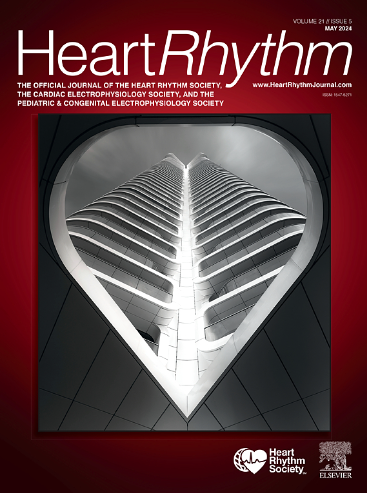源于主动脉-中轴持续部的局灶性房性心动过速:解剖学和电生理学特征。
IF 5.7
2区 医学
Q1 CARDIAC & CARDIOVASCULAR SYSTEMS
引用次数: 0
摘要
背景主动脉-窦房结连线(AMC)是局灶性房性心动过速(AT)不常见的起源部位。本研究的目的是详细描述 AMC ATs 的特征。方法本研究共纳入 650 例 ATs 患者,其中 21 例(3.2%)的 ATs 起源于 AMC。对患者进行了全面评估,包括心电图、电生理学检查、计算机断层扫描和心内超声心动图检查。这组患者的平均年龄为(48.9 ± 21.6)岁,其中 12 人为女性(57.1%)。17名患者的P波为典型的双相波,阳性成分突出。右心房最早激活的部位在 His 束附近,平均激活时间为 P 波前 -10.3 ± 6.0 毫秒。成功消融的目标分布如下:1 例位于 9 点钟位置,6 例位于 10 点钟位置,7 例位于 11 点钟位置,6 例位于 12 点钟位置,1 例位于左冠状动脉尖。局部 AMC 电位与通常认为的环状电位不同,其特点是 A 波突出,V 波较小(房室比为 1)。AMC ATs 组被左冠状动脉尖压迫的左心房前壁的侵袭角明显小于对照组,对照组由 40 名因胸痛接受冠状动脉 CT 扫描但无房性心律失常的患者随机抽取组成,这可能是导致心律失常的基质(141.7° ± 11.5° vs 155.2° ± 13.9°; P = .026)。消融目标的心房与心室比率应为 >1。本文章由计算机程序翻译,如有差异,请以英文原文为准。
Focal atrial tachycardias originating from the aorta-mitral continuity: Anatomical and electrophysiological characteristics
Background
The aorta-mitral annulus conjunction (AMC) is an uncommon site of origin of focal atrial tachycardias (ATs). Hence, the electrophysiological and ablation target characteristics are poorly described.
Objective
The purpose of this study was to describe the characteristics of AMC ATs in detail.
Methods
The study enrolled 650 patients with ATs, 21 (3.2%) of whom had ATs originating from the AMC. A comprehensive evaluation, including electrocardiography, electrophysiology study, computed tomography scan, and intracardiac echocardiography, was performed.
Results
The majority (19, 90.5%) of ATs occurred spontaneously. The mean age of this group was 48.9 ± 21.6 years, with 12 being female (57.1%). Seventeen patients had a typical biphasic P wave with a prominent positive component. The earliest activation site in the right atrium was near the His bundle, with average activation −10.3 ± 6.0 ms preceding the P wave. The successful ablation targets were distributed as follows: 1 case at 9 o’clock, 6 cases at 10 o’clock, 7 cases at 11 o’clock, 6 cases at 12 o’clock, and 1 case in the left coronary cusp. The local AMC potential differed from the commonly perceived annular potential and was characterized by a prominent A wave and a smaller V wave (atrial-to-ventricular ratio > 1). The angle of encroachment on the left atrial anterior wall, compressed by the left coronary cusp, was significantly smaller in the AMC ATs group than in the control group consisted of 40 patients who underwent coronary artery CT scans because of the chest pain but without atrial arrhythmias were randomly selected, which may have contributed to the arrhythmia substrate (141.7° ± 11.5° vs 155.2° ± 13.9°; P = .026).
Conclusion
A new strategy for mapping AMC ATs has been introduced. The ablation target should have an atrial-to-ventricular ratio of >1.
求助全文
通过发布文献求助,成功后即可免费获取论文全文。
去求助
来源期刊

Heart rhythm
医学-心血管系统
CiteScore
10.50
自引率
5.50%
发文量
1465
审稿时长
24 days
期刊介绍:
HeartRhythm, the official Journal of the Heart Rhythm Society and the Cardiac Electrophysiology Society, is a unique journal for fundamental discovery and clinical applicability.
HeartRhythm integrates the entire cardiac electrophysiology (EP) community from basic and clinical academic researchers, private practitioners, engineers, allied professionals, industry, and trainees, all of whom are vital and interdependent members of our EP community.
The Heart Rhythm Society is the international leader in science, education, and advocacy for cardiac arrhythmia professionals and patients, and the primary information resource on heart rhythm disorders. Its mission is to improve the care of patients by promoting research, education, and optimal health care policies and standards.
 求助内容:
求助内容: 应助结果提醒方式:
应助结果提醒方式:


